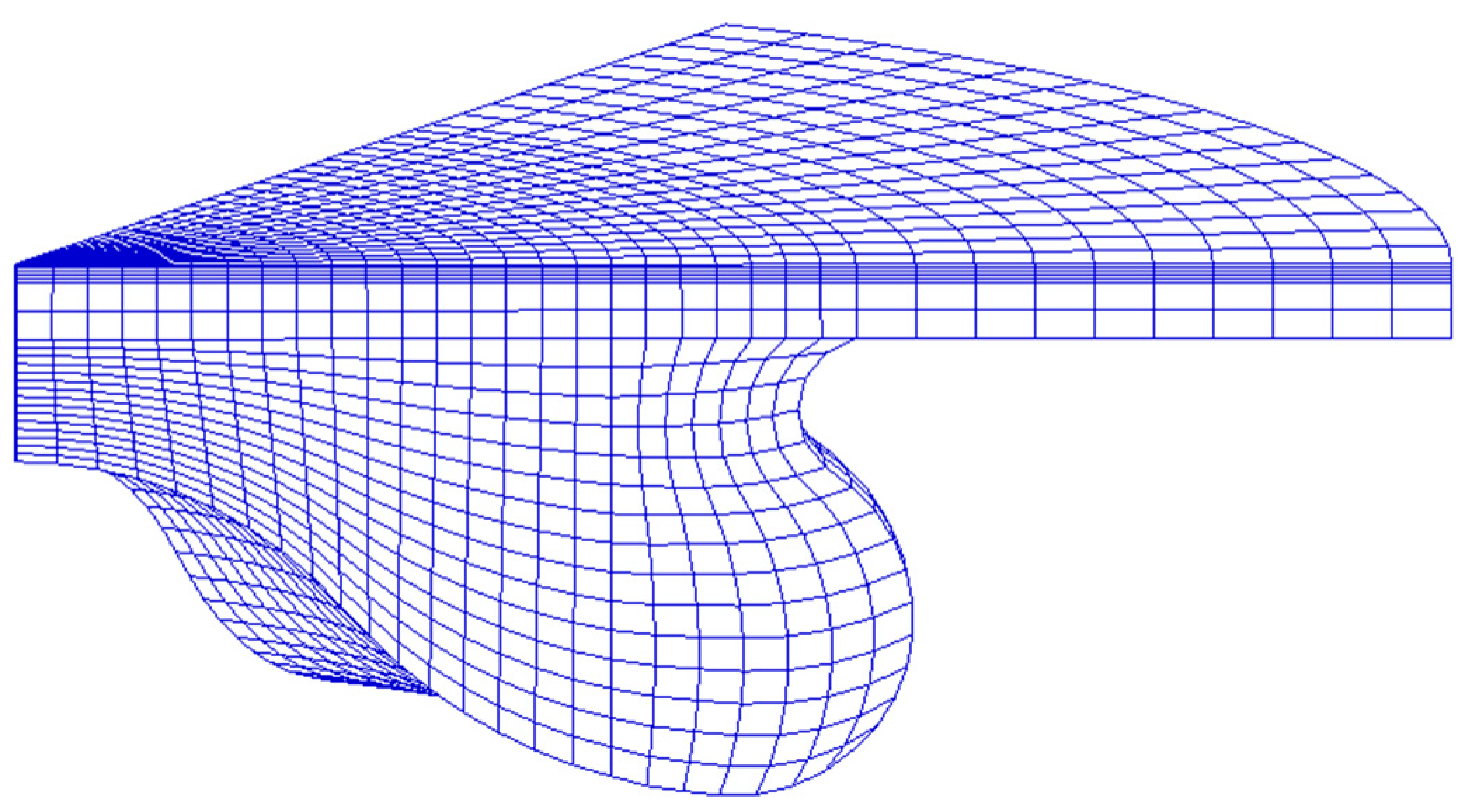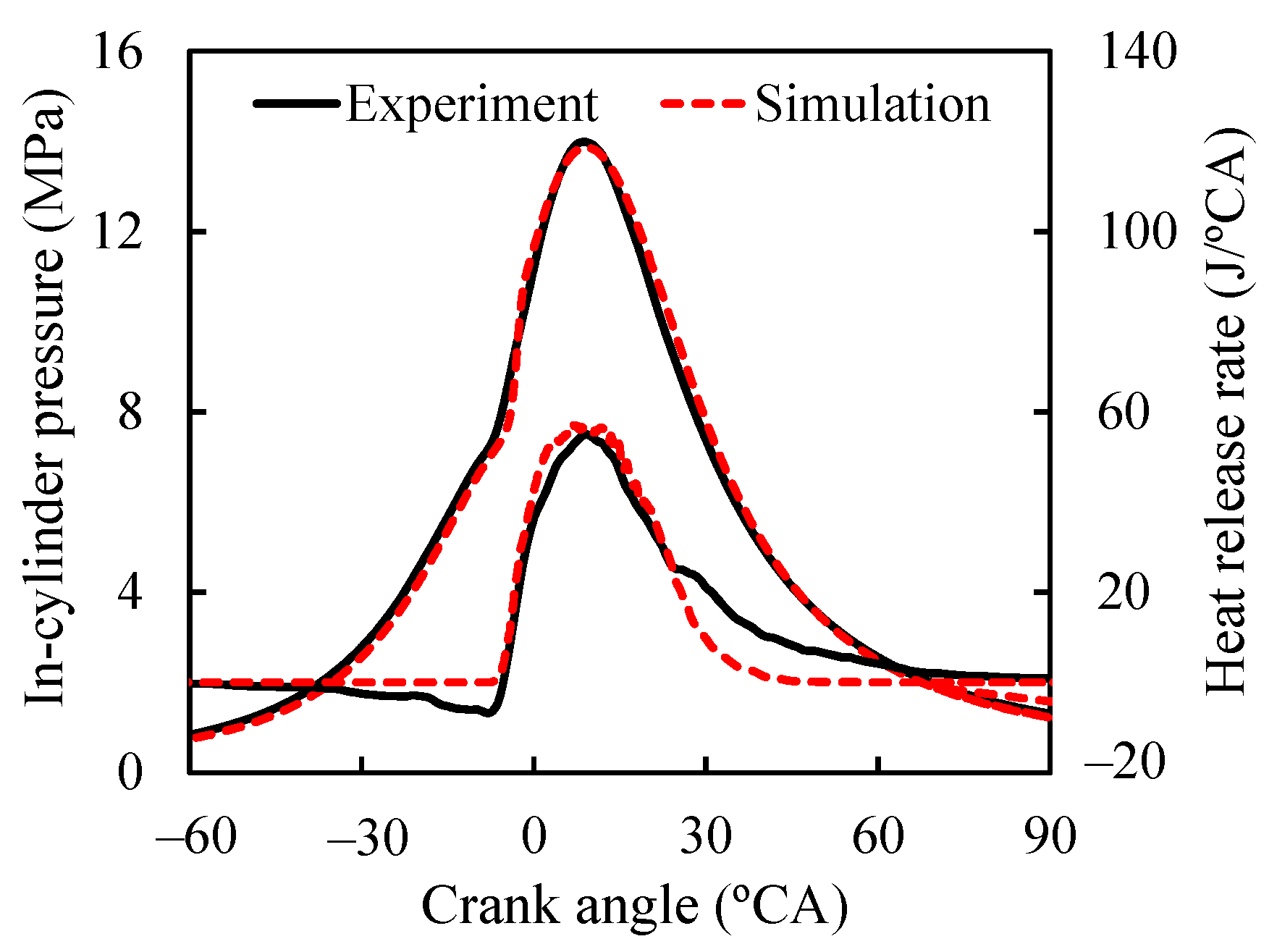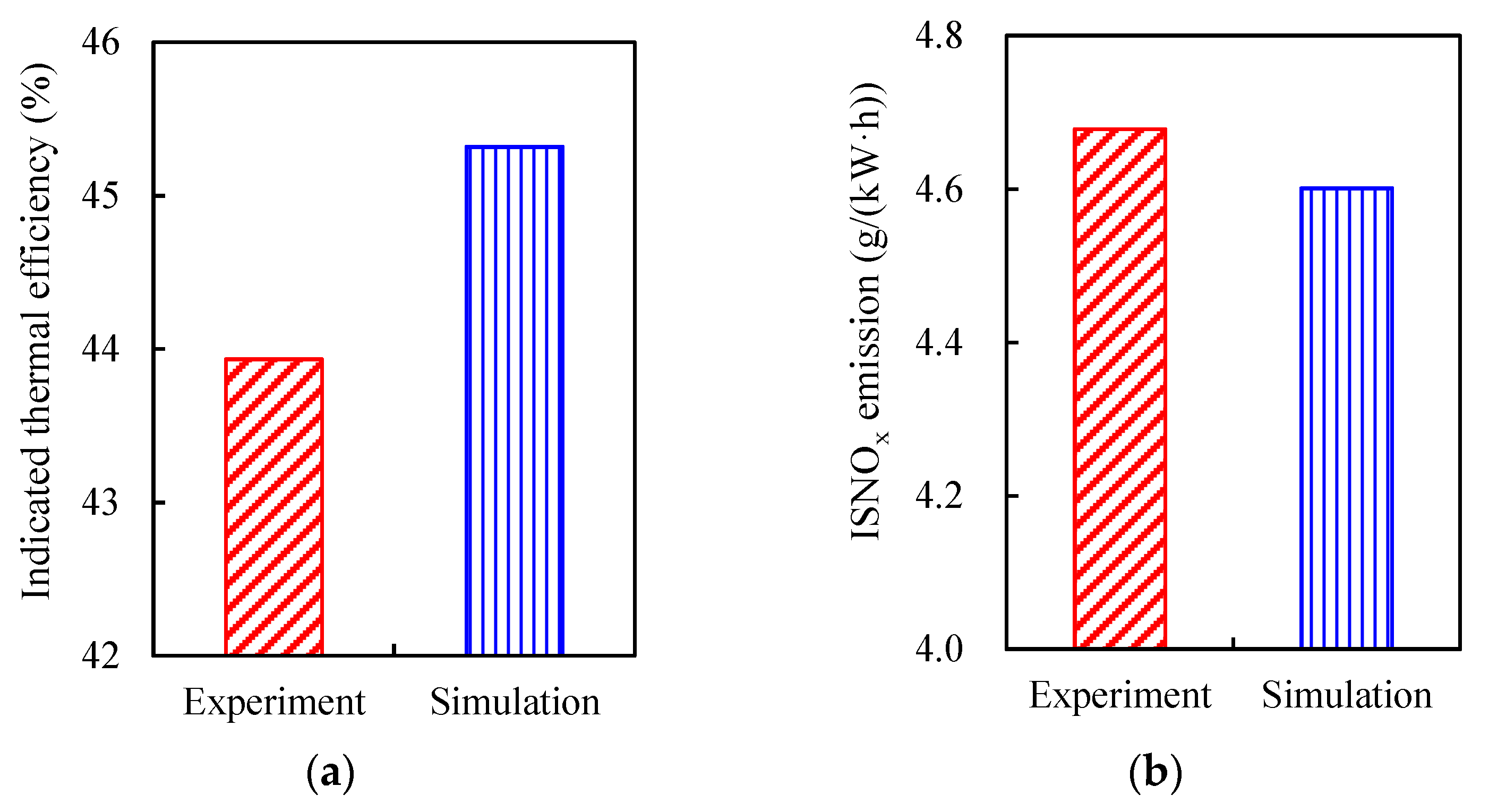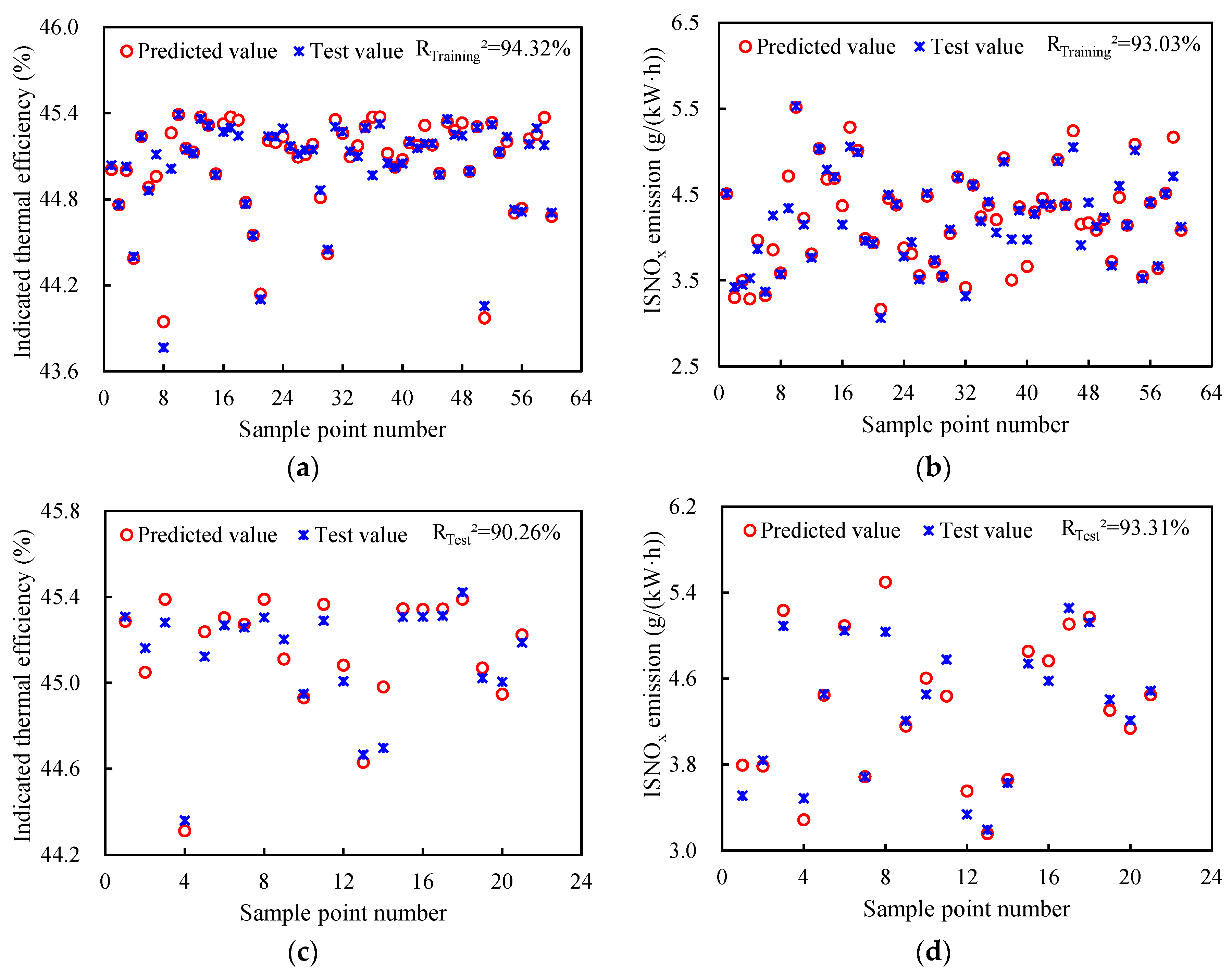Multi-Objective Optimization of the Structural Design of a Combustion Chamber of a Small Agricultural Diesel Engine Fueled with B20 Blend Fuel at a High Altitude Area
Abstract
:1. Introduction
2. Numerical Methodology
2.1. Establishment of the Numerical Model
2.2. Model Validation
3. Research Results and Analysis
3.1. Selection of Combustion Chamber Characteristics
3.2. Experiment Design
3.3. Model Building and Evaluation Based on BP Neural Network
3.4. Multi-Objective Optimization of Diesel Engine Dynamics and Emissions
4. Conclusions
Author Contributions
Funding
Institutional Review Board Statement
Informed Consent Statement
Data Availability Statement
Conflicts of Interest
References
- Du, Y.; Fu, S.; Mao, E.; Zhu, Z.; Li, Z. Development situation and prospects of intelligent design for agricultural machinery. Trans. Chin. Soc. Agric. Mach. 2019, 50, 1–17. [Google Scholar]
- Fu, M.; Ding, Y.; Yin, H.; Ji, Z.; Ge, Y.; Liang, B. Characteristics of agricultural tractors emissions under real-world operating cycle. Trans. Chin. Soc. Agric. Eng. 2013, 29, 42–48. [Google Scholar]
- Tan, P.; Wang, D.; Lou, D.; Hu, Z. Progress of control technologies on exhaust emissions for agricultural machinery. Trans. Chin. Soc. Agric. Eng. 2018, 34, 1–14. [Google Scholar] [CrossRef]
- Dahodwala, M.; Joshi, S.; Krishnamoorthy, H.; Koehler, E.W.; Franke, M. Evaluation of system configurations for downsizing a heavy-duty diesel engine for non-road applications. SAE Int. J. Engines 2016, 9, 2272–2285. [Google Scholar] [CrossRef]
- Wang, J.; Shen, L.; Wen, Y.; Zhao, J. Effects of atmospheric pressure on combustion and emission of a small agricultural diesel engine at idle condition. Trans. Chin. Soc. Agric. Eng. 2020, 36, 73–79. [Google Scholar]
- Ministry of Ecology and Environment of the People’s Republic of China. China Mobile Source Environmental Management Annual Report; Ministry of Ecology and Environment of the People’s Republic of China: Beijing, China, 2022. [Google Scholar]
- Yu, L.; Ge, Y.; Tan, J.; He, C.; Wang, X.; Liu, H.; Zhao, W.; Guo, J.; Fu, G.; Feng, X.; et al. Experimental investigation of the impact of biodiesel on the combustion and emission characteristics of a heavy duty diesel engine at various altitudes. Fuel 2014, 115, 220–226. [Google Scholar] [CrossRef]
- Liu, S.; Shen, L.; Bi, Y.; Lei, J. Effects of altitude and fuel oxygen content on the performance of a high pressure common rail diesel engine. Fuel 2014, 118, 243–249. [Google Scholar] [CrossRef]
- Shen, L.; Yang, Y.; Lei, J.; Bi, Y.; Yan, W.; Tang, Y. Study of performance and emission of a turbocharged inter-cooling diesel engine at different altitudes. Trans. CSICE 2006, 24, 250–255. [Google Scholar]
- Wang, X.; Yin, H.; Ge, Y.; Yu, L.; Xu, Z.; Yu, C.; Shi, X.; Liu, H. On-vehicle emission measurement of a light-duty diesel van at various speeds at high altitude. Atmos. Environ. 2013, 81, 263–269. [Google Scholar] [CrossRef]
- Nadimi, E.; Przybyła, G.; Emberson, D.; Løvås, T.; Ziółkowski, Ł.; Adamczyk, W. Effects of using ammonia as a primary fuel on engine performance and emissions in an ammonia/biodiesel dual-fuel CI engine. Int. J. Energy Res. 2022, 46, 15347–15361. [Google Scholar]
- Ma, Q.; Zhang, Q.; Liang, J.; Yang, C. The performance and emissions characteristics of diesel/biodiesel/alcohol blends in a diesel engine. Energy Rep. 2021, 7, 1016–1024. [Google Scholar] [CrossRef]
- Mahmudul, H.M.; Hagos, F.Y.; Mamat, R.; Adam, A.A.; Ishak, W.F.W.; Alenezi, R. Production, characterization and performance of biodiesel as an alternative fuel in diesel engines—A review. Renew. Sustain. Energy Rev. 2017, 72, 497–509. [Google Scholar]
- Suthisripok, T.; Semsamran, P. The impact of biodiesel B100 on a small agricultural diesel engine. Tribol. Int. 2018, 128, 397–409. [Google Scholar] [CrossRef]
- Shen, Y.; Li, W.; Chen, G.; Zhang, W.; Chen, C.; He, K. Effects of biodiesel on the performance and emission characteristics of CI engine running at high altitude region. Chin. Intern. Combust. Engine Eng. 2015, 36, 150–156. [Google Scholar]
- Si, P.; Chen, G.; Wang, X.; Mao, B.; Zheng, Z.; Yao, M. Effects of structure of combustion chamber and injector on heavy-duty diesel performance and emission characteristics. Trans. Chin. Soc. Agric. Mach. 2013, 44, 12–18. [Google Scholar]
- Chen, H.; Wei, S.; Tang, D.; Li, C. Numerical simulation on the combustion and emission characteristics of a diesel engine with double ω combustion chamber. Automot. Eng. 2014, 36, 423–431. [Google Scholar]
- Singh, P.; Tiwari, S.K.; Singh, R.; Kumar, N. Modification in combustion chamber geometry of CI engines for suitability of biodiesel: A review. Renew. Sustain. Energy Rev. 2017, 79, 101. [Google Scholar]
- Lei, J.; Yu, Y.; Xian, Q.; Shen, L.; Song, G. Investigation and application of systematic design method for combustion chamber of diesel engine. Trans. Chin. Soc. Agric. Eng. 2020, 36, 36–46. [Google Scholar]
- Taghavifar, H.; Khalilarya, S.; Jafarmadar, S. Engine structure modifications effect on the flow behavior, combustion, and performance characteristics of DI diesel engine. Energy Convers. Manag. 2014, 85, 20–32. [Google Scholar] [CrossRef]
- Zheng, Z.; Wang, X.; Wang, H.; Zhu, Z.; Deng, Y. Optimization study on combustion chamber of a stoichiometric combustion natural gas engine. Chin. Intern. Combust. Engine Eng. 2020, 41, 1–8. [Google Scholar]
- Guo, J.; Liu, Y.; Wu, B.; Su, W. Numerical simulation of piston bowl optimization for heavy-duty diesel engines with high charge density. Chin. Intern. Combust. Engine Eng. 2021, 42, 72–81. [Google Scholar]
- Zhang, Y.; Du, H.; Sun, C. A study on optimization of diesel engine combustion chamber based on numerical simulation. Chin. Intern. Combust. Engine Eng. 2018, 39, 87–92. [Google Scholar]
- Lee, J.; Jayun, C.; Dockoon, Y. A compression ratio selection method of the non-road diesel engine without EGR system to meet stage V emission standards. In Proceedings of the ASME 2017 Internal Combustion Engine Division Fall Technical Conference, Seattle, WA, USA, 15–18 October 2017; pp. 2017–3542. [Google Scholar]
- Liu, M.; Yao, M.; Wang, H.; Zheng, Z.; Liang, H. Numerical simulation of combustion chamber optimization for thermal efficiency improvement of heavy-duty diesel engine. J. Combust. Sci. Technol. 2022, 28, 355–362. [Google Scholar]
- Jaichandar, S.; Annamalai, K. Effects of open combustion chamber geometries on the performance of pongamia biodiesel in a DI diesel engine. Fuel 2012, 98, 272–279. [Google Scholar] [CrossRef]
- Jaichandar, S.; Kumar, P.S.; Annamalai, K. Combined effect of injection timing and combustion chamber geometry on the performance of a biodiesel fueled diesel engine. Energy 2012, 47, 388–394. [Google Scholar] [CrossRef]
- Jaichandar, S.; Annamalai, K. Combined impact of injection pressure and combustion chamber geometry on the performance of a biodiesel fueled diesel engine. Energy 2013, 55, 330–339. [Google Scholar] [CrossRef]
- Li, J.; Yang, W.; An, H.; Maghbouli, A.; Chou, S. Effects of piston bowl geometry on combustion and emission characteristics of biodiesel fueled diesel engines. Fuel 2014, 120, 66–73. [Google Scholar] [CrossRef]
- Premnath, S.; Devaradjane, G. Improving the performance and emission characteristics of a single cylinder diesel engine having reentrant combustion chamber using diesel and Jatropha methyl esters. Ecotoxicol. Environ. Saf. 2015, 121, 10–15. [Google Scholar] [CrossRef]
- Bapu, B.R.R.; Saravanakumar, L.; Prasad, B.D. Effects of combustion chamber geometry on combustion characteristics of a DI diesel engine fueled with calophyllum inophyllum methyl ester. J. Energy Inst. 2017, 90, 82–100. [Google Scholar] [CrossRef]
- Karthickeyan, V. Effect of combustion chamber bowl geometry modification on engine performance, combustion and emission characteristics of biodiesel fuelled diesel engine with its energy and exergy analysis. Energy 2019, 176, 830–852. [Google Scholar] [CrossRef]
- Khan, S.; Panua, R.; Bose, P.K. The impact of combustion chamber configuration on combustion and emissions of a single cylinder diesel engine fuelled with soybean methyl ester blends with diesel. Renew. Energy 2019, 143, 335–351. [Google Scholar] [CrossRef]
- Shivashimpi, M.M.; Alur, S.A.; Topannavar, S.N.; Dodamani, B.M. Combined effect of combustion chamber shapes and nozzle geometry on the performance and emission characteristics of CI engine operated on pongamia. Energy 2018, 154, 17–26. [Google Scholar] [CrossRef]
- Rajashekhar, C.R.; Chandrashekar, T.K.; Umashankar, C.; Kumar, R.H. Studies on effects of combustion chamber geometry and injection pressure on biodiesel combustion. Trans. Can. Soc. Mech. Eng. 2012, 36, 429–438. [Google Scholar] [CrossRef]
- Jia, G.; Tian, G.; Zhang, D. Effects of plateau environment on combustion and emission characteristics of a plateau high-pressure common-rail diesel engine with different blending ratios of biodiesel. Energies 2022, 15, 550. [Google Scholar] [CrossRef]
- Jiao, Y.; Liu, R.; Zhang, Z.; Yang, C.; Zhou, G.; Dong, S.; Liu, W. Comparison of combustion and emission characteristics of a diesel engine fueled with diesel and methanol-Fischer-Tropsch diesel-biodiesel-diesel blends at various altitudes. Fuel 2019, 243, 52–59. [Google Scholar] [CrossRef]
- Tan, Z.; Wang, J.; Chen, W.; Shen, L.; Bi, Y. Study on the influence of EGR on the combustion performance of biofuel diesel at different ambient simulated pressures. Sustainability 2021, 13, 7862. [Google Scholar] [CrossRef]
- Hao, C.; Ge, Y.; Wang, X. Heavy-duty diesel engine fuel consumption comparison with diesel and biodiesel measured at different altitudes. Int. J. Veh. Perform. 2020, 6, 263–276. [Google Scholar] [CrossRef]
- Li, X.; Zheng, Y.; Guan, C.; Cheung, C.S.; Huang, Z. Effect of biodiesel on PAH, OPAH, and NPAH emissions from a direct injection diesel engine. Environ. Sci. Pollut. Res. 2018, 25, 34131–34138. [Google Scholar] [CrossRef] [PubMed]
- Hanjalić, K.; Popovac, M.; Hadžiabdić, M. A robust near-wall elliptic-relaxation eddy-viscosity turbulence model for CFD. Int. J. Heat Fluid Flow 2004, 25, 1047–1051. [Google Scholar] [CrossRef]
- Dukowicz, J.K. Quasi-Steady Droplet Phase Change in the Presence of Convection; Los Alamos Scientific Laboratory: Los Alamos, NM, USA, 1979. [Google Scholar]
- Liu, A.B.; Mather, D.; Reitz, R.D. Modeling the effects of drop drag and breakup on fuel sprays. SAE Trans. 1993, 102, 83–95. [Google Scholar]
- Jiro, S.; Kobayashi, M.; Iwashita, S.; Fujimoto, H. Modeling of diesel spray impingement on a flat wall. SAE Trans. 1994, 103, 1918–1931. [Google Scholar]
- Colin, O.; Benkenida, A. The 3-zones extended coherent flame model (ECFM3Z) for computing premixed/diffusion combustion. Oil Gas Sci. Technol. 2004, 59, 593–609. [Google Scholar] [CrossRef]
- Komiyama, K.; Heywood, J.B. Predicting NOx emissions and effects of exhaust gas recirculation in spark-ignition engines. SAE Transactions 1973, 82, 1458–1476. [Google Scholar]
- An, H.; Yang, W.; Maghbouli, A.; Li, J.; Chua, K. AA skeletal mechanism for biodiesel blend surrogates combustion. Energy Convers. Manag. 2014, 81, 51–59. [Google Scholar] [CrossRef]
- Ambarish, D.; Samiddha, P.; Bijankumar, M. An experimental study on the performance and emission characteristics of a CI engine fueled with Jatropha biodiesel and its blends with diesel. J. Mech. Sci. Technol. 2014, 28, 1961–1966. [Google Scholar]







| Parameter | Value |
|---|---|
| Bore × stroke | 80 mm × 92 mm |
| Displacement | 1.85 L |
| Compression ratio | 16.5 |
| Rated power | 58 kW at 2500 r/min |
| Peak torque | 265 N·m at 1800 r/min |
| Parameters | Diesel | Biodiesel |
|---|---|---|
| Low calorific value | 42.65 MJ/kg | 38.56 MJ/kg |
| Hexadecane value | 53.1 | 56.1 |
| Density at 15 °C | 843.6 kg/m−3 | 875.9 kg/m−3 |
| Viscosity at 40 °C | 2.72 mm2/s | 4.29 mm2/s |
| Oxygen mass fraction | 0.0% | 10.0% |
| Level | Injection Cone Angle α (°) | Crater Radius r1 (mm) | Center Depth h (mm) | Throat Radius r2 (mm) |
|---|---|---|---|---|
| −1 | 153 | 4.0 | 4.0 | 20.5 |
| 0 | 156 | 5.0 | 5.5 | 21.5 |
| 1 | 159 | 6.0 | 7.0 | 22.5 |
| Item | Original Value | Optimal Value |
|---|---|---|
| Oil injection cone angle α (°) | 156.0 | 157.2 |
| Crater radius r1 (mm) | 5.0 | 4.2 |
| Center depth h (mm) | 5.5 | 5.0 |
| Throat radius r2 (mm) | 21.5 | 22.2 |
| Item | ITE (%) | ISNOx (g/(kW·h)) |
|---|---|---|
| D100 without Opt | 45.44 | 3.87 |
| D100 with Opt | 46.07 | 3.93 |
| B20 without Opt | 45.32 | 4.60 |
| B20 with Opt | 45.27 | 3.55 |
Disclaimer/Publisher’s Note: The statements, opinions and data contained in all publications are solely those of the individual author(s) and contributor(s) and not of MDPI and/or the editor(s). MDPI and/or the editor(s) disclaim responsibility for any injury to people or property resulting from any ideas, methods, instructions or products referred to in the content. |
© 2023 by the authors. Licensee MDPI, Basel, Switzerland. This article is an open access article distributed under the terms and conditions of the Creative Commons Attribution (CC BY) license (https://creativecommons.org/licenses/by/4.0/).
Share and Cite
Shi, Z.; Wang, J.; Guo, X.; Liu, X. Multi-Objective Optimization of the Structural Design of a Combustion Chamber of a Small Agricultural Diesel Engine Fueled with B20 Blend Fuel at a High Altitude Area. Sustainability 2023, 15, 11617. https://doi.org/10.3390/su151511617
Shi Z, Wang J, Guo X, Liu X. Multi-Objective Optimization of the Structural Design of a Combustion Chamber of a Small Agricultural Diesel Engine Fueled with B20 Blend Fuel at a High Altitude Area. Sustainability. 2023; 15(15):11617. https://doi.org/10.3390/su151511617
Chicago/Turabian StyleShi, Zhipeng, Jun Wang, Xiangchi Guo, and Xueyuan Liu. 2023. "Multi-Objective Optimization of the Structural Design of a Combustion Chamber of a Small Agricultural Diesel Engine Fueled with B20 Blend Fuel at a High Altitude Area" Sustainability 15, no. 15: 11617. https://doi.org/10.3390/su151511617





